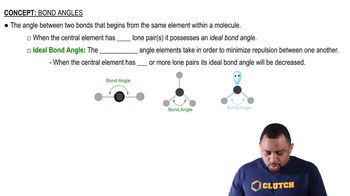Ethyl acetate, C4H8O2, is a fragrant substance used both as a solvent and as an aroma enhancer. Its Lewis structure is
a. What is the hybridization at each of the carbon atoms of the molecule?
 Verified step by step guidance
Verified step by step guidance



Ethyl acetate, C4H8O2, is a fragrant substance used both as a solvent and as an aroma enhancer. Its Lewis structure is
a. What is the hybridization at each of the carbon atoms of the molecule?
Ethyl acetate, C4H8O2, is a fragrant substance used both as a solvent and as an aroma enhancer. Its Lewis structure is
(c) How many of the valence electrons are used to make s bonds in the molecule?
Ethyl acetate, C4H8O2, is a fragrant substance used both as a solvent and as an aroma enhancer. Its Lewis structure is
(e) How many valence electrons remain in nonbonding pairs in the molecule?
Glycine, the simplest amino acid, has the following Lewis structure:
b. What are the hybridizations of the orbitals on the two oxygens and the nitrogen atom, and what are the approximate bond angles at the nitrogen?
Glycine, the simplest amino acid, has the following Lewis structure:
c. What is the total number of 𝜎 bonds in the entire molecule, and what is the total number of 𝜋 bonds?
d. Would you expect SO3 to exhibit delocalized 𝜋 bonding?